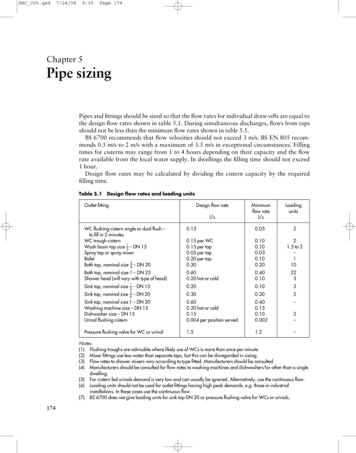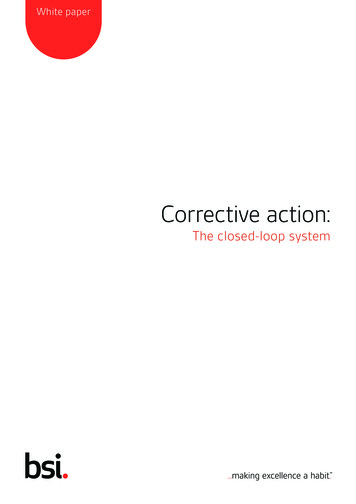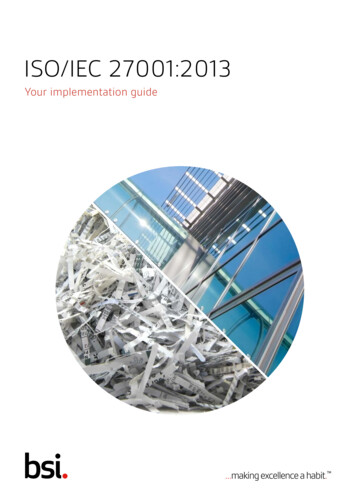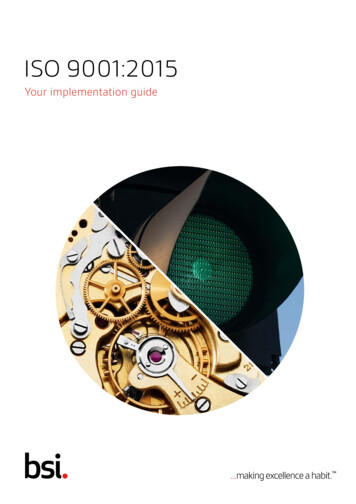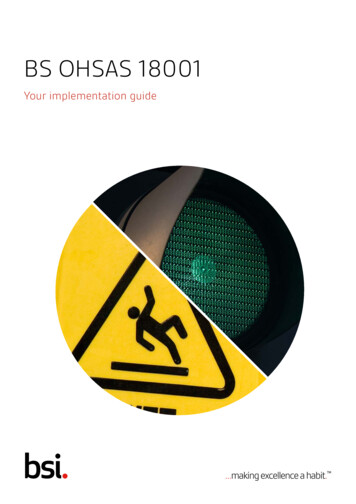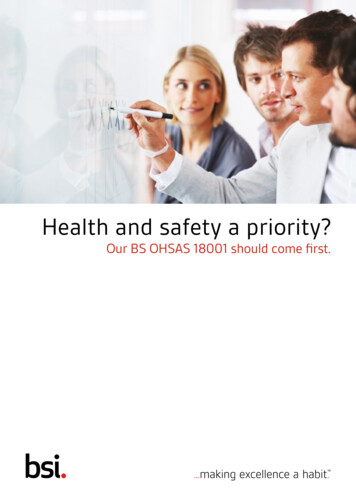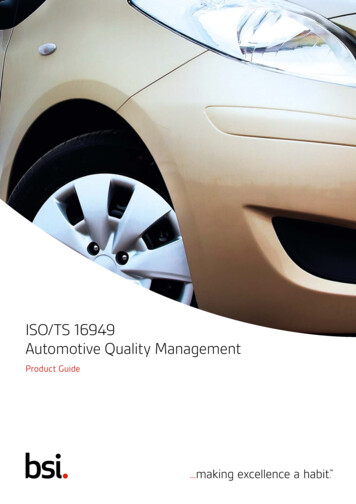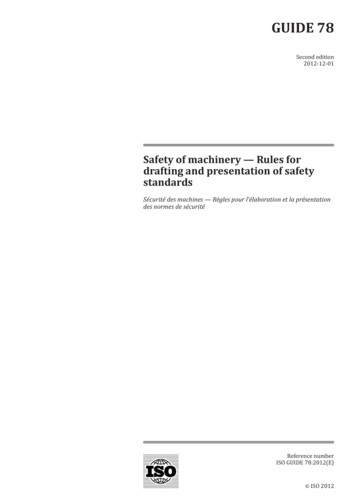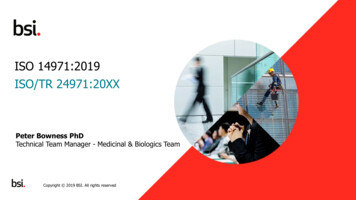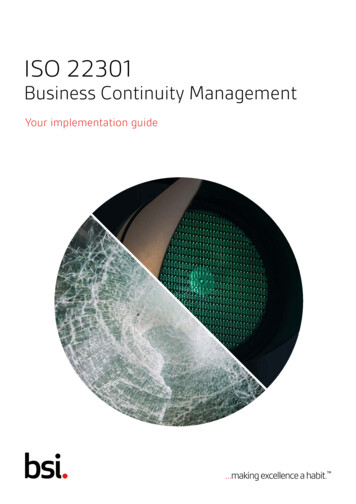
Transcription
Fifth EditionEssentials ofPublic SpeakingCheryl HamiltonTarrant County College—NE CampusAustralia Brazil Japan Korea Mexico Singapore Spain United Kingdom United States
This is an electronic version of the print textbook. Due to electronic rights restrictions,some third party content may be suppressed. Editorial review has deemed that any suppressedcontent does not materially affect the overall learning experience. The publisher reserves the rightto remove content from this title at any time if subsequent rights restrictions require it. Forvaluable information on pricing, previous editions, changes to current editions, and alternateformats, please visit www.cengage.com/highered to search by ISBN#, author, title, or keyword formaterials in your areas of interest.
Essentials of Public Speaking, Fifth EditionCheryl HamiltonExecutive Editor: Monica EckmanAssistant Editor: Rebekah MatthewsEditorial Assistant: Colin SolanMedia Editor: Jessica BadinerMarketing Manager: Amy WhitakerMarketing Coordinator: Gurpreet SaranMarketing Communications Manager:Caitlin GreenSenior Content Project Manager:Michael LeperaArt Director: Linda HelcherPrint Buyer: Justin Palmeiro 2012, 2009, 2006 Wadsworth, Cengage LearningALL RIGHTS RESERVED. No part of this work covered by the copyrightherein may be reproduced, transmitted, stored, or used in any formor by any means graphic, electronic, or mechanical, including but notlimited to photocopying, recording, scanning, digitizing, taping, Webdistribution, information networks, or information storage and retrievalsystems, except as permitted under Section 107 or 108 of the 1976United States Copyright Act, without the prior written permission ofthe publisher.For product information and technology assistance, contact us atCengage Learning Customer & Sales Support, 1-800-354-9706For permission to use material from this text or product,submit all requests online at www.cengage.com/permissions.Further permissions questions can be emailed topermissionrequest@cengage.com.Rights Acquisition Specialist, Image:Mandy GroszkoLibrary of Congress Control Number: 2011920244Rights Acquisition Specialist, Text:Shalice Shah-CaldwellISBN-13: 978-0-495-90113-6Production Service: Integra-ChicagoISBN-10: 0-495-90113-XText Designer: Lou Ann ThesingCover Image: Gene Lower/Contributor/Getty Images/ Getty Images; JermalCountess/WireImage/ Getty Images; JGL/Tom Grill/Blend Images/CorbisWadsworth20 Channel Center StreetBoston, MA 02210USACompositor: Integra-IndiaCengage Learning is a leading provider of customized learning solutionswith office locations around the globe, including Singapore, the UnitedKingdom, Australia, Mexico, Brazil, and Japan. Locate your local office at:international.cengage.com/regionCengage Learning products are represented in Canada byNelson Education, Ltd.For your course and learning solutions, visit www.cengage.com.Purchase any of our products at your local college store or at ourpreferred online store www.cengagebrain.com.Instructors: Please visit login.cengage.com and log in to accessinstructor-specific resources.Printed in the United States of America1 2 3 4 5 6 7 15 14 13 12 11
Essentials of Public Speaking, Fifth Edition,is dedicated to Doris S. Redd(I’m so lucky to have her for my mother—and she’s a great copyeditoras well! Thanks, Mom.)
Brief ContentsQuick Start Guide to Public SpeakingOne Foundations11 Public Speaking, Ethics, and You2 Building Speaker Confidence3 Listening: What Speakers and Listeners Should Know22747Two Preparing Your Speech71456772101123146Analyzing Your AudienceSelecting, Outlining, and Researching Your TopicSupporting Your IdeasOrganizing a Successful SpeechThree Presenting Your Speechivxxvii1798 Delivering Your Message9 Perfecting Language Style10 Preparing Effective Visual Aids180202222Four Types of Speeches24711 Informative Speaking12 Persuasive Speaking: Individual or Team13 Persuasive Methods and Theories14 Special Occasion 85
ContentsPrefaceQuick Start Guide to Public SpeakingxviixxviiONE Foundations1Unit One Quiz: Myths About Public Speaking1Chapter 1 Public Speaking, Ethics, and You2Public Speaking: Benefits in Your LifeEnhancing Your Personal Satisfaction and DevelopmentInfluencing Your WorldSpeaking to Make a Difference: Bill GatesAdvancing Your CareerActive Critical Thinking334568The Right Speech for the OccasionInformative Versus Persuasive SpeechesSpecial Occasion SpeechesActive Critical Thinking99910The Communication Process and the Public SpeakerSpeaker/ListenersStimulus and MotivationMessage Encoding and DecodingVerbal, Visual, and Vocal CodesFeedbackEnvironment/ContextNoiseActive Critical Thinking101011111313141414Ethics: The Public Speaker’s ObligationExamples and Costs of Unethical BehaviorExaggeration, Distortion, and PlagiarismPlagiarism and TechnologyClassroom EthicsActive Critical ThinkingSample Introductory Speech: “Closet Artifacts” by Monica E. WolfeSummaryEssentials of Public Speaking OnlineKey Terms15161717181920212222v
viCONTENTSPersonal Skill BuildingCollaborative Skill BuildingUnit One: Quiz Answers222425Chapter 2 Building Speaker Confidence27Understanding Communicator AnxietySituational AnxietyTrait AnxietyActive Critical Thinking28282930Managing Situational Anxiety30Prepare and PracticeWarm Up FirstUse Deep BreathingPlan an Introduction to Relax You and Your ListenersConcentrate on MeaningUse Visual AidsUse Positive ImageryActive Critical Thinking3031313132323233Managing Trait Anxiety: Positive ImageryWhy Positive Imagery WorksMastering Positive ImagerySpeaking to Make a Difference: Arnold SchwarzeneggerPracticing Positive ImageryActive Critical Thinking333435363941Other Methods for Managing AnxietyActive Critical ThinkingSummaryEssentials of Public Speaking OnlineKey TermsPersonal Skill BuildingCollaborative Skill Building41434344444445Chapter 3 Listening: What Speakers and ListenersShould Know47Stages of ListeningThe Receive StageThe Comprehend StageThe Interpret StageThe Evaluate StageThe Respond StageThe Memory StageActive Critical Thinking4848494950515152Listening FiltersCultureGender525355
CONTENTSTechnologyActive Critical Thinking5657Stage: Stimulating and Motivating Your Audience to ListenStimulate and Motivate Your AudienceGrab Audience Attention: Stimulate ThemSpeaking to Make a Difference: Barbara JordanKeep Audience Attention: Motivate Them5757575859Comprehend Stage: Maximize Listeners’ UnderstandingMaximize Listeners’ Understanding5959Interpret Stage: Don’t Get Caught by the 100 PercentCommunication Myth61Evaluate Stage: Counteract Listeners’ Resistance to PersuasionStrengthen Your Personal CredibilityHighlight the Credibility of Your SourcesKeep Listeners from Evading Your MessageKeep the Listeners’ Attention on the Speech6161626263Respond Stage: Read Listeners’ Feedback CuesPut Feedback Cues in ContextDon’t Generalize from Single Listener ResponseLook for Subtle Signs of Inattention or Low-Level Listening63646464Memory Stage: Make Your Message Easier to RememberIncorporate Cues to Aid MemoryDon’t State Key Ideas in the First or Second SentenceUse Visuals to Enhance Listening and RememberingActive Critical ThinkingSummaryEssentials of Public Speaking OnlineKey TermsPersonal Skill BuildingCollaborative Skill Building65656666676768686869TWO Preparing Your Speech71Unit Two Quiz: Speech Preparation71Chapter 4 Analyzing Your Audience72Analyzing Your Audience: Situational InformationActive Critical Thinking7375Analyzing Your Audience: Demographic InformationIdentifying Specific Demographic CharacteristicsUsing Technology to Search for Cultural Demographic Information757577Choosing Which Demographic Characteristics to UseActive Critical Thinking7878vii
viiiCONTENTSAnalyzing Your Audience: Psychological InformationValuesBeliefsAttitudesNeedsHazards of Incomplete Psychological AnalysisActive Critical ThinkingSpeaking to Make a Difference: Dave Carroll7979808081828384Analyzing Audience ReceptivityActive Critical Thinking8586Sample Informative Speech: “Our Solar System and the Three Dwarves”by Kara Hoekstra86Collecting and Using Audience InformationBefore the SpeechAfter the SpeechUsing Audience AnalysisActive Critical ThinkingSummaryEssentials of Public Speaking OnlineKey TermsPersonal Skill BuildingCollaborative Skill BuildingUnit Two: Quiz Answers9090929395969696979898Chapter 5 Selecting, Outlining, and ResearchingYour Topic101Selecting Your Topic, Purpose, and Main PointsDetermine Your TopicSpeaking to Make a Difference: Harry MarkopolosDefine Your Exact PurposeDetermine Your Main Points102102105106107Preparing a Rough-Draft OutlineActive Critical Thinking108111Researching Your TopicAvoid Research MistakesBegin with Printed MaterialsUse Licensed Electronic Databases When PossibleUse the Internet with CareConduct Personal InterviewsRecord Research Information Carefully to Avoid PlagiarismActive Critical ThinkingSummaryEssentials of Public Speaking OnlineKey TermsPersonal Skill BuildingCollaborative Skill Building111111112113113118119120120120121121122
CONTENTSChapter 6 Supporting Your Ideas123Supporting Materials: OverviewTypes of SupportsReasons for Using SupportsTips for Using Supports EffectivelyActive Critical Thinking124124125125126Overused Supports—Use Them with Care!ExplanationsStatisticsActive Critical Thinking126127127130Underused Supports—Use Them More OftenInstances (Examples and Illustrations)Comparisons: Literal and FigurativeExpert OpinionsFables, Sayings, Poems, and RhymesSpeaking to Make a Difference: Christopher ReeveDemonstrationsActive Critical ThinkingSummaryEssentials of Public Speaking OnlineKey TermsPersonal Skill BuildingCollaborative Skill pter 7 Organizing a Successful Speech146Organization: How Important Is It?Active Critical Thinking147148Organizing the Body of Your SpeechSelecting an Informative Pattern of OrganizationSelecting a Persuasive Pattern of OrganizationActive Critical Thinking148149151155Organizing the Introduction of Your SpeechGoal 1: Catch the Audience’s AttentionSample IntroductionSpeaking to Make a Difference: Ann RichardsGoal 2: Motivate Your Audience to ListenGoal 3: Establish Credibility and RapportGoal 4: Present Your Thesis StatementOptional Content for Speech IntroductionsActive Critical Thinking156156157161163163164165165Organizing the Conclusion of Your SpeechSample ConclusionSummarize Main IdeasRefocus Audience AttentionUsing Q&AActive Critical Thinking166166167167169170ix
xCONTENTSPolishing Your SpeechPolishing Using a Preparation OutlinePolishing by Adding Transitions and ConnectorsActive Critical ThinkingSummaryEssentials of Public Speaking OnlineKey TermsPersonal Skill BuildingCollaborative Skill BuildingTHREE Presenting Your Speech170170173175175176176176177179Unit Three Quiz: Verbal, Vocal, and Visual Delivery179Chapter 8 Delivering Your Message180Selecting the Best Method of DeliverySpeaking from Brief Notes (Extemporaneous Speaking)Speaking from Visual Aids (Also Extemporaneous Speaking)Speaking ImpromptuBelievable SpeakersSpeaking from a ManuscriptSpeaking from MemoryActive Critical Thinking181181181181182184184184Polishing Your Delivery: Verbal, Visual, and VocalVerbal DeliveryVisual DeliverySpeaking to Make a Difference: Martin Luther King, Jr.Vocal DeliveryImmediacy BehaviorsActive Critical ThinkingQuiz: Testing Your Knowledge of Delivery185185186187192195195196Practicing Your SpeechActive Critical ThinkingSummaryEssentials of Public Speaking OnlineKey TermsPersonal Skill BuildingCollaborative Skill BuildingUnit Three: Quiz Answers196198198198199199200200Chapter 9 Perfecting Language Style202Why Language Choices Are So ImportantActive Critical Thinking203204Effective Language StyleSimple LanguageSpecific Language204204205
CONTENTSVivid LanguageForceful LanguageActive Critical ThinkingStylistic DevicesAlliteration and ationRepetition and ParallelismSimile and MetaphorSpeaking to Make a Difference: Abraham LincolnQuiz: Testing Your Knowledge of Stylistic DevicesActive Critical Biased LanguageGender BiasCulture BiasActive Critical Thinking214214214215Sample Persuasive Speech: “Endometriosis”by Rebecca DeCamp215SummaryEssentials of Public Speaking OnlineKey TermsPersonal Skill BuildingCollaborative Skill BuildingChapter 10 Preparing Effective Visual AidsBenefits of Using Visual AidsVisual Aids Speed Comprehension and Add InterestVisual Aids Improve Audience Memory and Recall of ContentVisual Aids Decrease Presentation TimeVisual Aids Improve Speaker CredibilityActive Critical Thinking218219219219220222223223224225225226Types of Visual AidsActive Critical Thinking226227Planning Your Visual AidsBegin with Your Audience in MindConsider the Benefits of Using ColorDetermine the Types and Number of Visuals to UseMake PowerPoint Your AllyActive Critical Thinking228228228229229230Using Basic Design PrinciplesActive Critical ThinkingSpeaking to Make a Difference: Steve Jobs230232233xi
xiiCONTENTSDesigning Your Visual AidsTIP #1: Use the Correct Font Size234234Color Insert (follows p. 228)TIP #2: Select Fonts with CareTIP #3: Follow Design Tips for Text SlidesTIP #4: Follow Design Tips for Graphic SlidesTIP #5: Use Color With Extra CareActive Critical Thinking235235237239240Using PowerPoint to Customize Your Visuals240Guidelines For Using Your Visual Aids Effectively242SummaryEssentials of Public Speaking OnlineKey TermsPersonal Skill BuildingCollaborative Skill BuildingFOUR Types of Speeches244244244244245247Unit Four Quiz: Preparing Different Types of Speeches247Chapter 11 Informative Speaking248Informative Speaking: OverviewWhat Is an Informative SpeechDemonstration Speeches249249250Sample Demonstration Speech: “Origami for Storytelling”by Cassandra FerrellInformational Speeches250253Sample Informational Speech: “Bacterial Meningitis” by Emily WilsonActive Critical Thinking253256Tools to Aid Understanding and MemoryDefinitionDescriptionExplanationNarrationThe “Stickiness Factor”Active Critical ThinkingSpeaking to Make a Difference: Barbara Bush257257257257258259259260Steps in Preparing an Informative SpeechAnalyze Your Potential AudienceDetermine Your Topic, Exact Purpose, and Main PointsPrepare a Rough-Draft Outline of Main Points and Desired InformationResearch Your Topic, Looking for Quality Supporting MaterialsDetermine How Best to Organize Main PointsPlan Your Introduction and ConclusionQuiz: Testing Your Knowledge of Organizational Patterns261261262262262264264265
CONTENTSMake a Preparation Outline, Apply Critical Thinking, and Plan Speaking NotesPrepare Visual AidsPractice Your Speech Both Physically and TechnologicallySummaryEssentials of Public Speaking OnlineKey TermsPersonal Skill BuildingCollaborative Skill BuildingUnit Four: Quiz AnswersChapter 12 Persuasive Speaking: Individual or Team266270271272273273273274274277Persuasive Speaking: An OverviewWhat Is a Persuasive Speech?How Do Persuasive and Informative Speeches Differ?What is an Effective Argument?What Appeals Make a Speech Really Persuasive?Active Critical Thinking278278280282283283Types of Persuasive SpeechesThe Speech to ConvinceThe Speech to ActuateThe Speech to Stimulate or Intensify Social CohesionSpeaking to Make a Difference: John F. KennedyActive Critical Thinking283283284284285287Sample Persuasive Speech: “Drinking and Driving”by Lorna McElaney287Preparing Your Persuasive SpeechDetermine Your Topic, Position Statement, and Type of SpeechAnalyze Audience Attitudes Toward Your PositionPrepare a Rough-Draft Outline of Main Points and Needed InformationResearch Your TopicSelect the Best Supporting MaterialsDetermine How Best to Organize Your Main PointsQuiz: Testing Your Knowledge of Persuasive PatternsPlan the Introduction and ConclusionMake Preparation Outlines and Speaking NotesPrepare Visual Aids and Practice Your SpeechActive Critical ting Speeches—Yours and Others304Sample Persuasive Speech with Analysis: “Cell Phones: Don’t Chat and Drive”by Cedrick McBeth304Active Critical Thinking307Team PresentationsEffective Team PresentationsTeam Presentation FormatsProblem Solving for Team PresentationsActive Critical Thinking307308309310312xiii
xivCONTENTSSummaryEssentials of Public Speaking OnlineKey TermsPersonal Skill BuildingCollaborative Skill BuildingChapter 13 Persuasive Methods and Theories312313313313314316Logos: Using Evidence and Logic SkillfullyEvidence and Logic DefinedEvidence and Logic as Persuasive ToolsMethods of Presenting EvidenceWhether to Present One or Both Sides of Your PositionLogical ReasoningFallacious ReasoningActive Critical Thinking317317317319321322323325Ethos: Establishing CredibilityCredibility as a Persuasive ToolBasic Elements of CredibilityUnethical Use of CredibilityActive Critical Thinking326326327328328Pathos: Appealing to Listeners’ Psychological NeedsPersonalizing Your Persuasive ArgumentSpeaking to Make a Difference: Mary FisherGetting Your Audience InvolvedUsing Maslow’s Hierarchy of NeedsFear AppealsUnethical Use of Emotional AppealsActive Critical Thinking329329330331331333334334Using Persuasion and TechnologyActive Critical Thinking335335Using Persuasive Theory When SpeakingElaboration Likelihood Model of PersuasionSocial Judgment TheoryActive Critical Thinking336336336338Sample Persuasive Speech: “Together, We Can Stop Cyber-Bullying”by Adam ParrishSummaryEssentials of Public Speaking OnlineKey TermsPersonal Skill BuildingCollaborative Skill Building338343344344344346
CONTENTSChapter 14 Special Occasion Speaking347Special Occasion Speaking: An OverviewOrganization of Special Occasion SpeechesPurposes of Special Occasion SpeakingActive Critical Thinking348348350350Speeches of IntroductionActive Critical Thinking350353Award PresentationsActive Critical Thinking353354Acceptance SpeechesActive Critical Thinking354355Commemorative SpeechesTributesToasts355355356Sample Speech of Tribute: “My Grandfather, John Flanagan Sr.”by Tara FlanaganEulogiesSpeaking to Make a Difference: Eulogy by President ObamaActive Critical Thinking356358359360After-Dinner SpeechesActive Critical ThinkingSummaryEssentials of Public Speaking OnlineKey TermsPersonal Skill BuildingCollaborative Skill 379Index385xv
This page intentionally left blank
PrefaceDo you want to improve your relationships, your ability to land and excelat jobs, your self-esteem, and even your health and happiness? Improving yourcommunication and speaking skills in a course like this one can help with all theseareas of your life. However, if you are like the typical person today, you are so busythat you only have time for the basics.Essentials of Public Speaking was created with you—the busy person—in mind.This text outlines the essentials of making a successful speech that really communicates with your audience without burdening you with unnecessary filler. Forexample, some of the practical and essential topics covered in this book include:How and why to analyze your audience.Selecting a powerful topic.Researching important facts and interesting supporting materials without wasting time.Ways to incorporate current technology.Managing your anxiety.Delivering your speech with enthusiasm and power.Designing and using professional visual aids.Although Essentials is based on contemporary research as well as classical rhetorical theory, the approach is very practical and reader-friendly. Concepts and skillsaren’t just explained—they are illustrated with interesting and relevant examples,real student speeches, and excerpts from professional speakers. One student reviewersaid she found the text so interesting and enjoyable that she read far more thanrequested!Features of the New EditionUpdated to include the most current information and examples, the Fourth Editionof Essentials continues to focus on the absolute essentials of public speaking.New Features Flash Forward: Each chapter includes a new Flash Forward feature thatrelates the Flash Back advice from ancient Roman and Greek orators totoday’s world and asks a critical thinking question to stimulate discussionon the chapter content.Chapter Objectives: The “Key Questions” that began each chapter in thefourth edition have been turned into chapter objectives in the currentedition. These chapter objectives serve as a guide to what is in the chapterand what the reader should know when they finish reading it.Active Critical Thinking Questions: Each major heading is followed by oneor two Active Critical Thinking questions to stimulate student thinking.xvii
xviiiPREFACE Students can complete these questions on their own or they can beassigned (especially helpful for online student activities).Personal Skill Building: The activities at the end of each chapter are dividedinto two parts. The Personal Skill Building activities are one of them.These activities provide practice and critical thinking questions for theindividual student.Collaborative Skill Building: The second type of activities provided at the endof each chapter is the Collaborative Skill Building activities which providepractice and critical thinking for small groups or the class as a whole.Speaking to Make a Difference: The “Speakers Who Made a Difference”feature from the last edition was changed to “Speaking to Make aDifference” so some contemporary speakers could be added to the historicalspeakers who used their speaking skills to inspire, persuade, or enlightenon a broad scale. Still included are the contextual information about eachspeaker and the speaking occasion, an excerpt from the speech, a briefanalysis of the speech, and questions for discussion. Most of the speeches areavailable in video and/or audio format online, and links are provided. Newspeakers added include musician David Carroll (Chapter 4), financial expertHarry Markopolos (Chapter 5), and President Barack Obama (Chapter 14),Speakers carried over from the previous edition include Bill Gates, ArnoldSchwarzenegger, Barbara Jordan, Christopher Reeve, Ann Richards,Martin Luther King, Jr., Abraham Lincoln, Steve Jobs, Barbara Bush, JohnF. Kennedy, and Mary Fisher.Special Occasion Speaking: A new chapter on special occasion speaking wasadded as Chapter 14—the original chapter 8 was omitted with contentmoved to various other chapters, which keeps our chapter count at 14.New student speeches: New student speeches were added to this edition aswell as speech analysis added in the margins of four speeches to provideplenty of models and explanation for students at all stages of the speechpreparation process. New speeches include “Endometriosis” by RebeccaDeCamp; “Bacterial Meningitis” by Emily Wilson; and “Together, WeCan Stop Cyber-Bullying” by Adam Parrish; and “My Grandfather, JohnFlanagan Sr” by Tara Flanagan.Updated Features Quick Start Guide: Don’t overlook the revised Quick Start Guide whichis a handy guide for students that helps them give quality speeches at thebeginning of the course without having to jump ahead in their book forneeded information. This guide is not intended to take the place of thedetailed information presented throughout the textbook, but rather to helpstudents get up to speed for their first speeches and then serve as a handyreference guide for later speeches.The Speech Communication CourseMate brings concepts to life withonline interactive learning, study, and exam preparation tools. TheCourseMate for Essentials of Public Speaking contains dynamic tools tomaximize students’ experiences by enabling them to read, watch, listen to,critique, and analyze the sample speeches provided. It also includesnumerous student and instructor resources, including Web links,
PREFACE interactive version of the Personal Report of CommunicationApprehension (PRCA-24), PowerPoint tutorials, an appendix of samplespeeches, a digital glossary, speech preparation forms and evaluationSee the Studentchecklists, and chapter-by-chapter practice quizzes.Resources section for more about the CourseMate for Essentials ofPublic Speaking.Continued emphasis on critical thinking: Critical thinking is emphasizedthroughout the book in several ways. “Test Your Knowledge”questionnaires at the beginning of each unit stimulate and direct studentthinking toward the material presented in the unit. The “Flash Back”feature boxes that begin each chapter present advice given by famousGreek and Roman rhetoricians and the new “Flash Forward” featureencourages students to compare classical rhetoric to contemporarypublic speaking. The new “Active Critical Thinking” questions at theend of each major heading in each chapter stimulate student thinking.Also, the “Personal Skill Building” activities and the “CollaborativeSkill Building” activities at the end of each chapter includes questions,activities, and prompts to InfoTrac College Edition articles designed topromote critical thinking. Finally, specific chapters, such as Chapter 3,“Listening: What Speakers and Listeners Should Know;” Chapter 4,“Analyzing Your Audience;” Chapter 11, “Informative Speeches:Demonstrational and Informational;” and Chapter 13, “PersuasiveMethods and Theories,” relate directly to the importance and use ofcritical thinking in public speaking.Sample student speeches, speech excerpts, and speech topics: Nine sample studentspeeches are featured throughout the text with one informative speech,“Our Solar System and the Three Dwarves,” and one persuasive speech,“Drinking and Driving,” used as running examples throughout the text.Four new speeches were added in this edition for a total of nine samplespeeches.Major reorganization in four chapters; revised material in all chapters: Manychapters have received major reorganization especially chapters 7, 10, 11,and 13 and one chapter was removed entirely to cut out redundancy.New photos were added throughout. Revised materials include: Chapter 2. Update on “Other Methods for Managing Anxiety”Chapter 3. Title changed to indicated that listening now includes(1) what speakers need to know about listeners, and (2) whatlistening skills listeners need to develop. Chapter also includes new“Stages of listening.”Chapter 5. Updated information on using the Internet.Chapter 6. New information on supporting materials and new,updated examples of each support.Chapter 7. New Patterns of organization added.Chapter 8. Examples changed or updated.Chapter 9. New persuasive speech on Endometriosis.Chapter 10. Benefits of using visuals reorganized and updated;entire Chapter reorganized; new visuals.xix
xxPREFACE Chapter 11. Demonstration and Informational speeches now haveevaluation included in margins; one new speech on endometriosis.Chapter 12. New information on persuasion, effective arguments,and persuasive appeals.Chapter 12 & 13: both have been reorganized for clarity and ease ofstudent reading. Also, more relevant photos.Chapter 13. Persuasive theory updated along with more practicalapplication of theory. New persuasive speech on cyber-bullying.Chapter 14. New chapter on Special Occasion Speaking; Eulogy byPresident Obama and a sample speech of tribute.Public Speaking EssentialsEssentials of Active Learning Students are invited to take an active role in thelearning process by evaluating sample student and professional speeches, takingthe “Test Your Knowledge” and online practice quizzes, and making decisionsabout his or her own speeches. Speech evaluation forms and sample formats forpreparing informative and persuasive speeches are included for student use. Eachchapter begins with a “Flashback” that makes classical rhetorical theory interestingand relevant and a “Flash Forward” that encourages application to today’s world.“Remember” boxes provide opportunities to stop and review. Special tidbits andadvice that will help students prepare and deliver quality speeches are integratedthroughout the text. To encourage students to reflect on and expand on whatthey have read, “Active Critical Thinking” questions are included at the endof each major chapter section and “Personal Skill Building” and “CollaborativeSkill Building” activities are included at the end of each chapter. In addition, atappropriate places in each chapter, the margins include InfoTrac College Editionexercises and “Express Connect” prompts to Speech Builder Express, an onlinespeech organization and outlining tool.Essentials of Confidence Building Speaker anxiety often keeps students fromachieving success. Unfortunately, no amount of lecture, encouragement, or practice will make students confident, professional speakers as long as deep downinside they believe themselves to be “poor” speakers. For this reason, Essentialsof Public Speaking approaches anxiety head-on in Chapter 2, “Building SpeakerConfidence,” so students can have improvements well under way by the time theirfirst major speech is due. Although a variety of confidence-building techniquesare discussed, Chapter 2 concentrates on positive imagery. This technique requiresonly minor instructor guidance and does not need special out-of-class sessions to besuccessful. In fact, interested students can use positive imagery with success simplyby following the suggestions in the text.Essentials of a Quick Start Instructors want students to begin speaking early inthe semester, but they know that to give good speeches, students need informationnot available until later chapters. Essentials of Public Speaking opens with a QuickStart Guide so that students can begin giving quality speeches immediately without
PREFACEhaving to jump ahead for needed information. This guide highlights the essential characteristics of a successful public speaker and provides an overview of thebasic speaking process. Beg
Essentials of Public Speaking Cheryl Hamilton Tarrant County College—NE Campus Fifth Edition . The Communication Process and the Public Speaker 10 Speaker/Listeners 10 Stimulus and Motivation 11 Message Encoding and D
